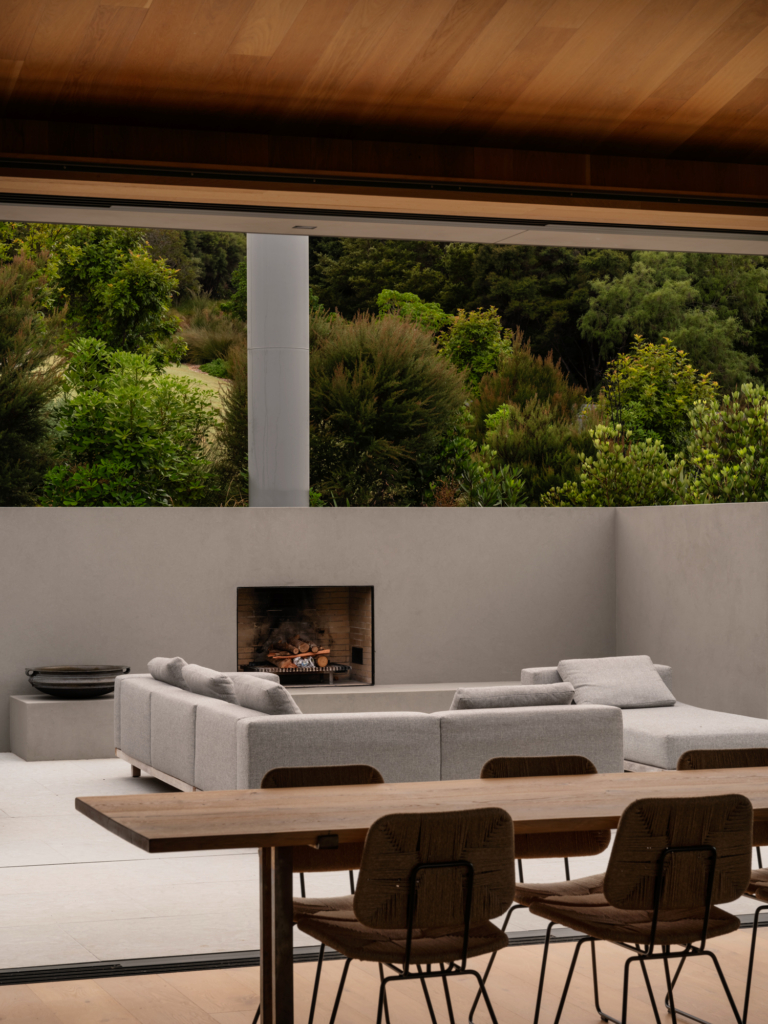
A Place to Put Down Roots – Moonee Ponds Residence by Architecton
The Melbourne home that Architecton Director Nick Lukas designed for himself and his family balances the simplicity of rectilinear forms and raw materials such as concrete, steel and glass with elegant, detailed interiors.
Externally, the architecture reads as a series of intersecting light and dark planes. Despite the abundance of glass, the front façade is deliberately closed, with a deep setback and double-height off-form concrete wall creating a sense of protection from the street. Operable black louvre screens create an additional layer across the glazing that allows the level of privacy and sunlight to be
controlled.
With both the exterior screen and the curtains inside covering the glass, it is the entry points that create a sense of volume. The dark front door and basement garage are inset slightly into the building, which draws the eye inward. The parallel lines that define the landscaping also emphasise these points of entry, with walls, paths and garden beds all leading into the house, creating a sequence that moves from the street, through the garden, to arrive at the entrance.
“The concrete wall is almost seven metres high, and from opening up the gate from the footpath you’re immediately confronted with that,” Nick says. “The door is intentionally offset so that you walk into a garden space at the front, the concrete wall becomes quite confronting and then there’s the opposing wall that leads you into the house through the big pivot door.”
The project was not experimental, he explains, rather, it is the result of design ideas honed over the years. “It was the third build for my wife Katrina and I, the second one with kids, so we learned through those experiences what works for us, the spaces that become comfortable for us as a family,” he says. This is evident in the project’s materiality (in particular, the use of off-form concrete and raw steel), the meticulous dedication to the design intent, and the relationship between interior spaces and the outdoors.
Off-form concrete was a key element of the design from the beginning. Moving from the front of the building, where the concrete double-height wall is the dominant structure, the rawness of the material is juxtaposed and balanced with a palette of refined materials. Where, externally, the monolithic quality of the material predominates, internally, these aspects create a minimalist yet raw envelope into which more elegant and refined elements are layered. This, in turn, brings out the nuances of the architecture.
With an approach that focused on enhancing and expressing the essential qualities of different materials, natural stone and delicate Japanese tiles play an important role in the interiors. “Materiality was based on textural qualities and focused on materials that didn’t appear to be something else,” Nick explains.
“In the children’s ensuites, the porcelain tiles have a rich character – they’re not just a shiny flat surface. In the master ensuite, we used three different textures of the same stone, so there’s that continuity at play there,” he says. Meanwhile, the sheen of the glaze and linear laying pattern of the tiled wall behind the bar creates an effect similar to water cascading down glass. In front of this tiled expanse, the stone bar hangs suspended, the mass of the stone contrasting with its floating appearance in a juxtaposition between the application of the material and its nature that heightens one’s sense of the materiality.
Balancing the weighty presence of the concrete walls, large expanses of glass visually connect the interior to the garden outside. While the project may not have been experimental in nature it did deliver the opportunity for Nick to commit to fulfilling challenging details. When first putting pen to paper for the design of the rear glazing, the span and height of the glass was a key aspect of the design, however, there was no manufacturer in Australia that could source a piece of glass of that scale.
The mass of the stone contrasting with its floating appearance in a juxtaposition between the application of the material and its nature that heightens one’s sense of the materiality.
“Many people would say ‘let’s just add a column or a mullion in here to make it work’ but to me, it was super important to get that aspect between the interior and the rear garden,” Nick recalls. “So, we had to get a commercial contractor on board just for the rear façade, and the glazing was sourced directly from China. It was a logistical nightmare, but I was stubborn enough to stick to my guns and get what was important.”
Living in the home now, Nick and his family are experiencing the connection to the landscape that this glazing affords, both in terms of the quality of the light that shifts throughout the day and the growth and changes in the garden over the seasons. “Seeing the light changing the morning through to the afternoon, and even between summer and autumn – we can really notice the difference. Another equally nice aspect is seeing the landscaping coming into fruition,” Nick says.
As the culmination of both the experience of building several previous homes and Nick’s practice as an architect, the house represents what is most important to the family. Driven by this design intent, architecture, interiors and landscape all come together to create a place where they can settle and put down roots.














